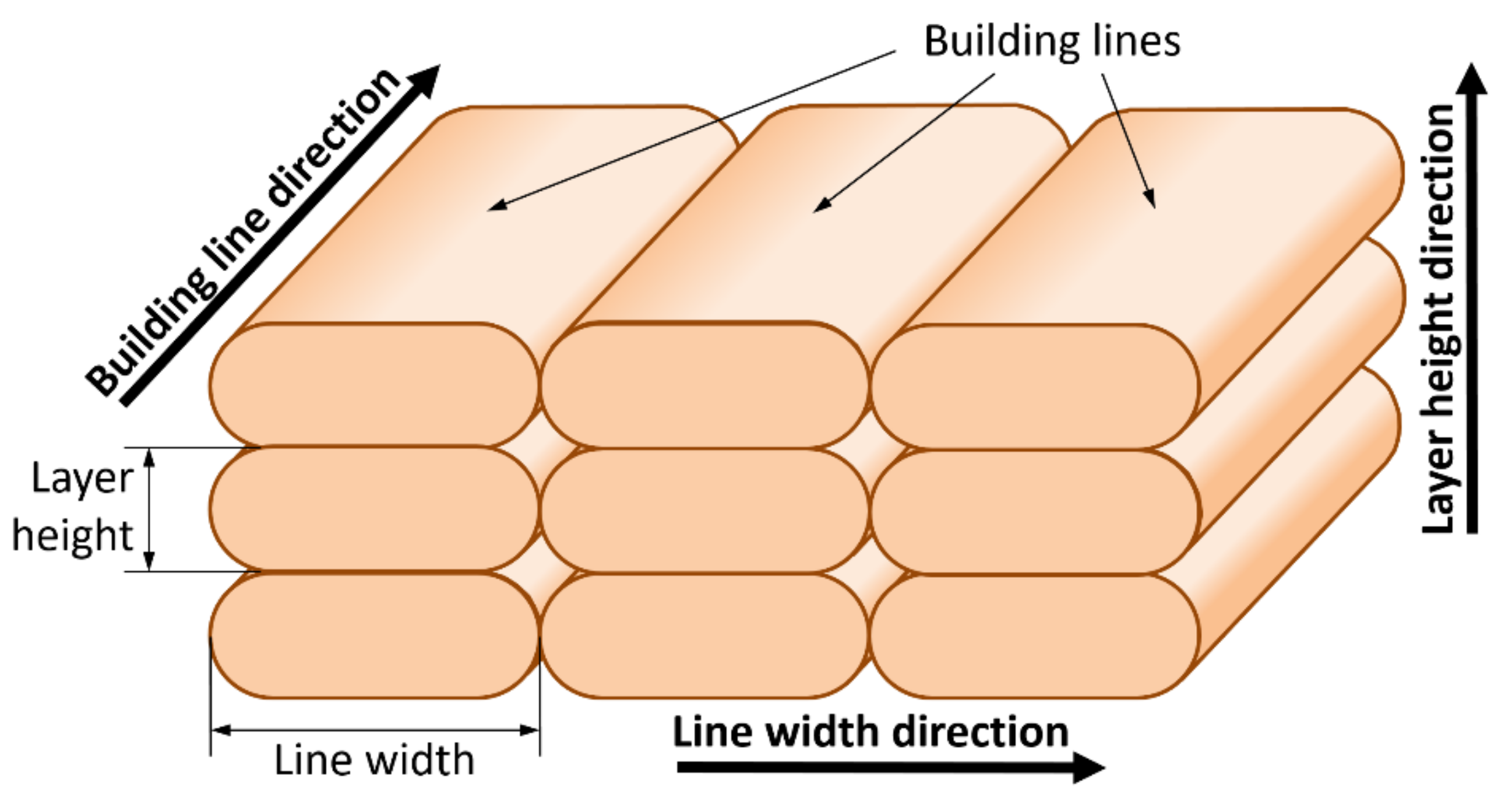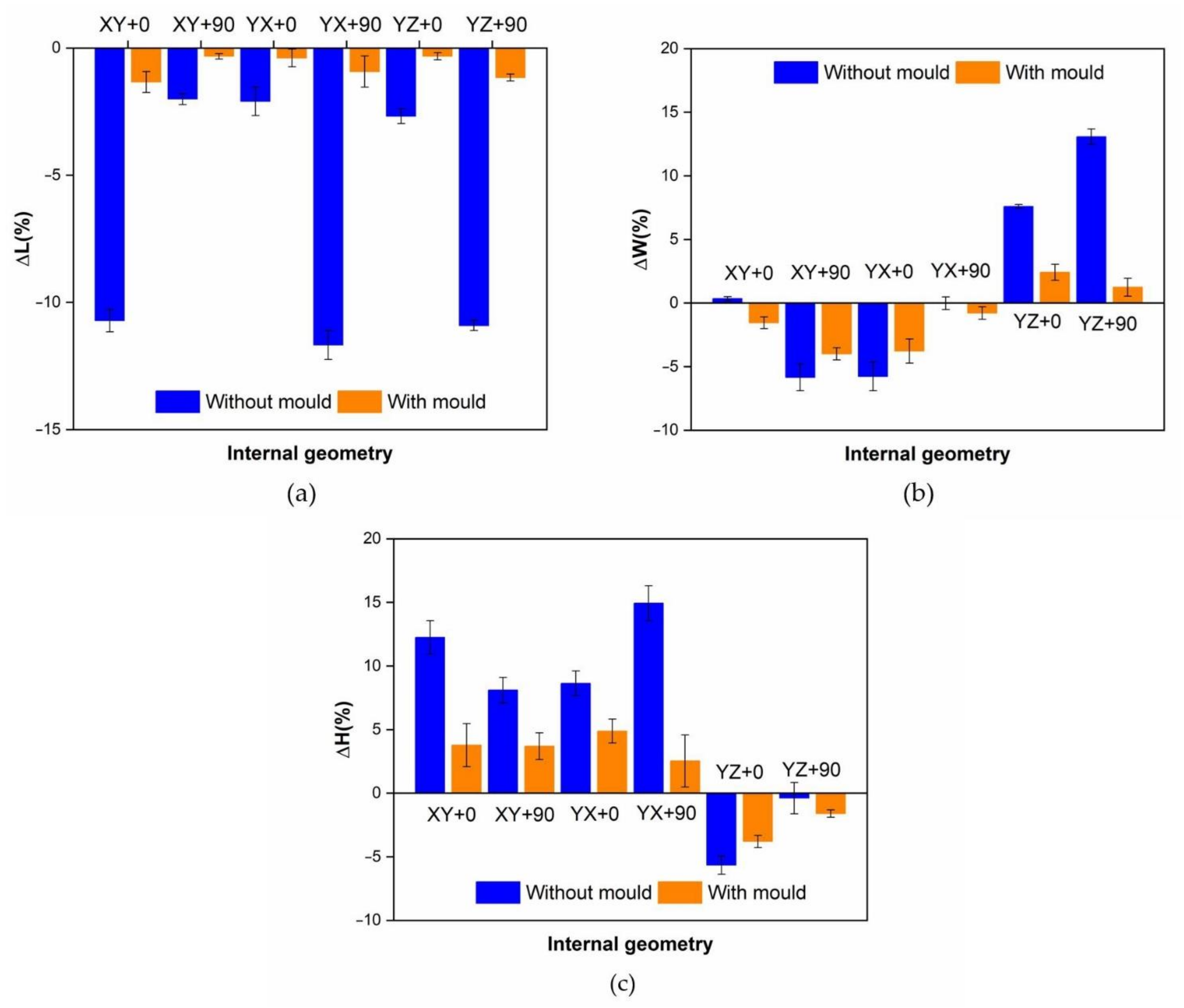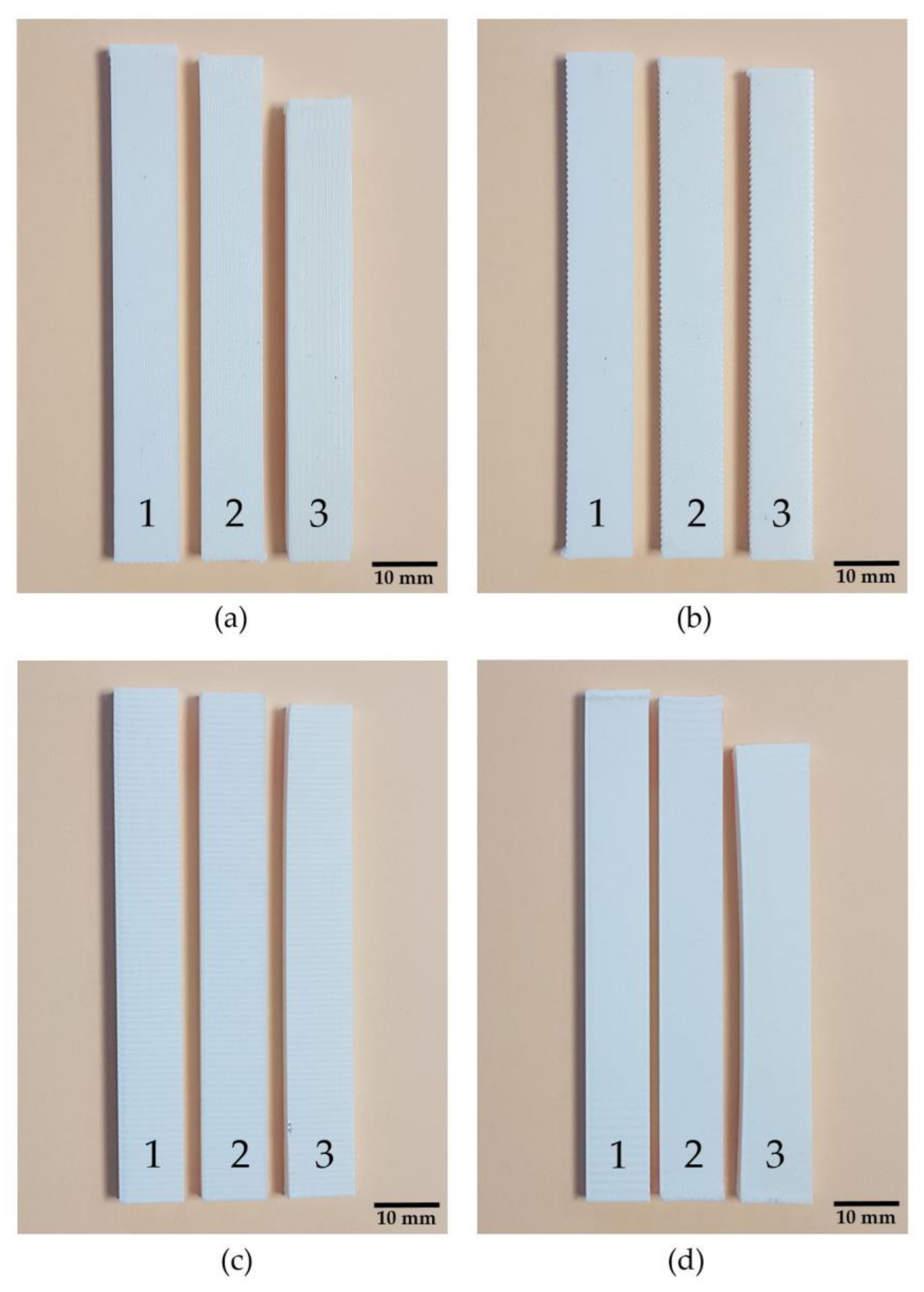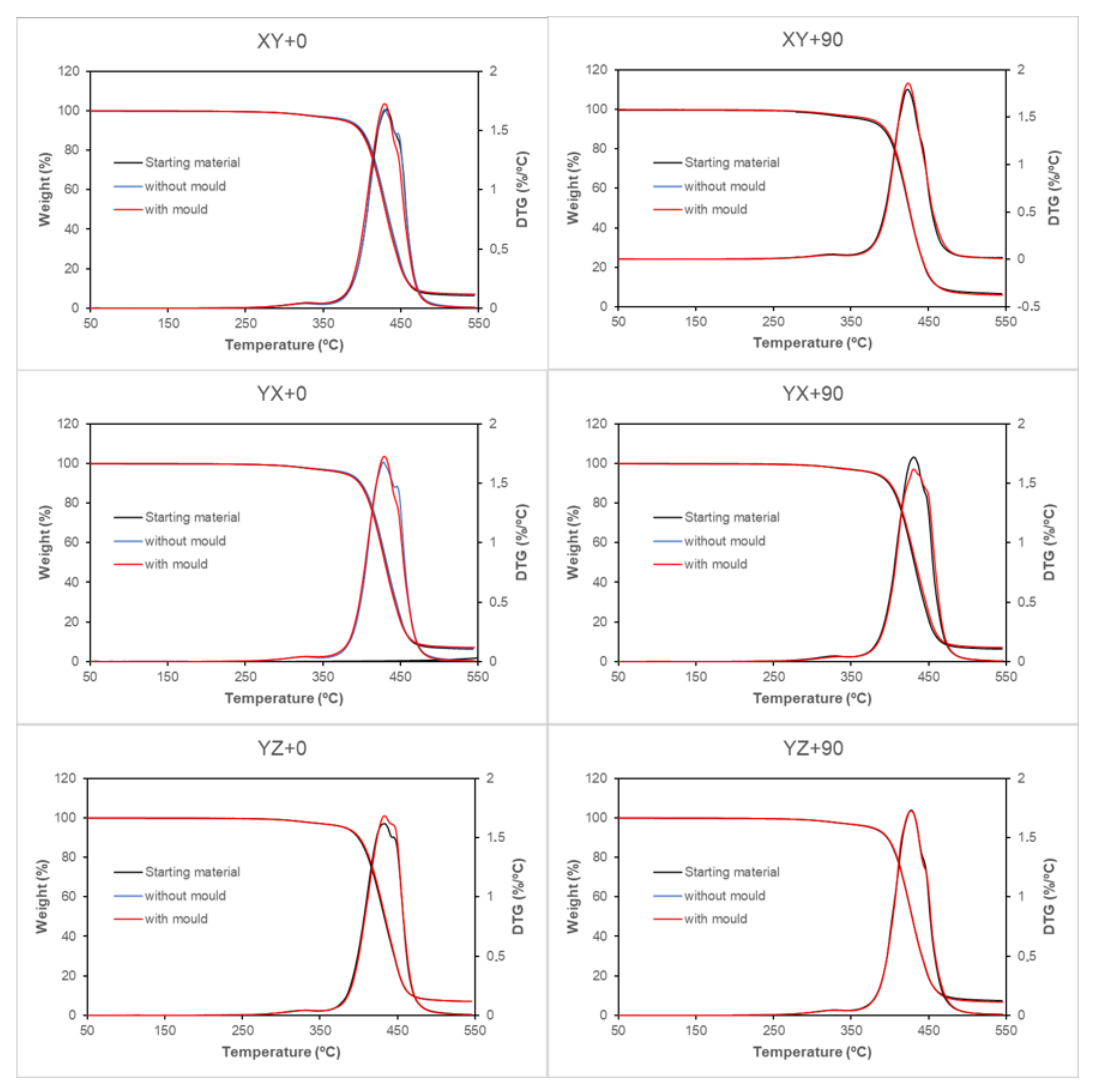Effect of a Powder Mould in the Post-Process Thermal Treatment of ABS Parts Manufactured with FDM Technology
Abstract
:1. Introduction
2. Materials and Methods
2.1. Test Specimens Design and Manufacturing
Internal Geometry
2.2. Thermal Post-Process Treatment
2.3. Design of Experiments
2.4. Thermogravimetric Analysis
3. Results and Discussion
3.1. Internal Geometry Influence
3.2. Ceramic Mould Effectiveness
3.3. Thermogravimetric Analysis
4. Conclusions
Author Contributions
Funding
Conflicts of Interest
References
- Ngo, T.D.; Kashani, A.; Imbalzano, G.; Nguyen, K.T.Q.; Hui, D. Additive manufacturing (3D printing): A review of materials, methods, applications and challenges. Compos. Part B Eng. 2018, 143, 172–196. [Google Scholar] [CrossRef]
- Ahn, S.H.; Montero, M.; Odell, D.; Roundy, S.; Wright, P.K. Anisotropic material properties of fused deposition modeling ABS. Rapid Prototyp. J. 2002, 8, 248–257. [Google Scholar] [CrossRef] [Green Version]
- Ziemian, C.; Sharma, M.; Ziemi, S. Anisotropic Mechanical Properties of ABS Parts Fabricated by Fused Deposition Modelling. Mech. Eng. 2012, 23, 2397. [Google Scholar] [CrossRef] [Green Version]
- Cantrell, J.T.; Rohde, S.; Damiani, D.; Gurnani, R.; DiSandro, L.; Anton, J.; Young, A.; Jerez, A.; Steinbach, D.; Kroese, C.; et al. Experimental characterization of the mechanical properties of 3D-printed ABS and polycarbonate parts. Rapid Prototyp. J. 2017, 23, 811–824. [Google Scholar] [CrossRef]
- Behalek, L.; Safka, J.; Seidl, M.; Habr, J.; Bobek, J. Fused deposition modelling vs. Injection moulding: Influence of fiber orientation and layer thickness on the mechanical properties. MM Sci. J. 2018, 2018, 2722–2726. [Google Scholar] [CrossRef]
- Popescu, D.; Zapciu, A.; Amza, C.; Baciu, F.; Marinescu, R. FDM process parameters influence over the mechanical properties of polymer specimens: A review. Polym. Test. 2018, 69, 157–166. [Google Scholar] [CrossRef]
- Turner, B.N.; Strong, R.; Gold, S.A. A review of melt extrusion additive manufacturing processes: I. Process design and modeling. Rapid Prototyp. J. 2014, 20, 192–204. [Google Scholar] [CrossRef]
- Cole, D.P.; Riddick, J.C.; Iftekhar Jaim, H.M.; Strawhecker, K.E.; Zander, N.E. Interfacial mechanical behavior of 3D printed ABS. J. Appl. Polym. Sci. 2016, 133, 1–12. [Google Scholar] [CrossRef]
- Wang, X.; Zhao, L.; Fuh, J.Y.H.; Lee, H.P. Effect of porosity on mechanical properties of 3D printed polymers: Experiments and micromechanical modeling based on X-ray computed tomography analysis. Polymers 2019, 11, 1154. [Google Scholar] [CrossRef] [Green Version]
- El Moumen, A.; Tarfaoui, M.; Lafdi, K. Modelling of the temperature and residual stress fields during 3D printing of polymer composites. Int. J. Adv. Manuf. Technol. 2019, 104, 1661–1676. [Google Scholar] [CrossRef]
- Morales, N.G.; Fleck, T.J.; Rhoads, J.F. The effect of interlayer cooling on the mechanical properties of components printed via fused deposition. Addit. Manuf. 2018, 24, 243–248. [Google Scholar] [CrossRef]
- Dillon, B.; Doran, P.; Fuenmayor, E.; Healy, A.V.; Gately, N.M.; Major, I.; Lyons, J.G. Influence of annealing and biaxial expansion on the properties of poly(l-lactic acid) medical tubing. Polymers 2019, 11, 1172. [Google Scholar] [CrossRef] [PubMed] [Green Version]
- Kousiatza, C.; Karalekas, D. In-situ monitoring of strain and temperature distributions during fused deposition modeling process. Mater. Des. 2016, 97, 400–406. [Google Scholar] [CrossRef]
- Budzik, G.; Woźniak, J.; Paszkiewicz, A.; Przeszłowski, Ł.; Dziubek, T.; Dębski, M. Methodology for the quality control process of additive manufacturing products made of polymer materials. Materials 2021, 14, 2202. [Google Scholar] [CrossRef] [PubMed]
- Rodríguez-Panes, A.; Claver, J.; Camacho, A.M. The influence of manufacturing parameters on the mechanical behaviour of PLA and ABS pieces manufactured by FDM: A comparative analysis. Materials 2018, 11, 1333. [Google Scholar] [CrossRef] [PubMed] [Green Version]
- Lluch-Cerezo, J.; Benavente, R.; Meseguer, M.D.; Gutiérrez, S.C. Study of samples geometry to analyze mechanical properties in Fused Deposition Modeling process (FDM). Procedia Manuf. 2019, 41, 890–897. [Google Scholar] [CrossRef]
- Riddick, J.C.; Haile, M.A.; Wahlde, R.V.; Cole, D.P.; Bamiduro, O.; Johnson, T.E. Fractographic analysis of tensile failure of acrylonitrile-butadiene-styrene fabricated by fused deposition modeling. Addit. Manuf. 2016, 11, 49–59. [Google Scholar] [CrossRef]
- Zhang, Y.; Chou, K. A parametric study of part distortions in fused deposition modelling using three-dimensional finite element analysis. Proc. Inst. Mech. Eng. Part B J. Eng. Manuf. 2008, 222, 959–967. [Google Scholar] [CrossRef]
- Dawoud, M.; Taha, I.; Ebeid, S.J. Mechanical behaviour of ABS: An experimental study using FDM and injection moulding techniques. J. Manuf. Process. 2016, 21, 39–45. [Google Scholar] [CrossRef]
- Khosravani, M.R.; Schüürmann, J.; Berto, F.; Reinicke, T. On the post-processing of 3d-printed abs parts. Polymers 2021, 13, 1559. [Google Scholar] [CrossRef]
- Moradi, M.; Moghadam, M.K.; Shamsborhan, M.; Bodaghi, M.; Falavandi, H. Post-processing of FDM 3d-printed polylactic acid parts by laser beam cutting. Polymers 2020, 12, 550. [Google Scholar] [CrossRef] [Green Version]
- Pazhamannil, R.V. Effect of Process Parameters and Thermal Annealing on Mechanical Properties of Fused Filament Fabricated Specimens. SSRN Electron. J. 2021, 358–364. [Google Scholar] [CrossRef]
- Donadei, V.; Lionetto, F.; Wielandt, M.; Offringa, A.; Maffezzoli, A. Effects of blank quality on press-formed PEKK/Carbon composite parts. Materials 2018, 11, 1063. [Google Scholar] [CrossRef] [Green Version]
- Singh, S.; Singh, M.; Prakash, C.; Gupta, M.K.; Mia, M.; Singh, R. Optimization and reliability analysis to improve surface quality and mechanical characteristics of heat-treated fused filament fabricated parts. Int. J. Adv. Manuf. Technol. 2019, 102, 1521–1536. [Google Scholar] [CrossRef]
- Butt, J.; Bhaskar, R. Investigating the effects of annealing on the mechanical properties of FFF-printed thermoplastics. J. Manuf. Mater. Process. 2020, 4, 38. [Google Scholar] [CrossRef]
- Kościuszko, A.; Marciniak, D.; Sykutera, D. Post-processing time dependence of shrinkage and mechanical properties of injection-molded polypropylene. Materials 2021, 14, 22. [Google Scholar] [CrossRef] [PubMed]
- Rangisetty, S.; Peel, L.D. The effect of infill patterns and annealing on mechanical properties of additively manufactured thermoplastic composites. In Proceedings of the ASME 2017 Conference on Smart Materials, Adaptive Structures and Intelligent Systems, SMASIS 2017, Snowbird, UT, USA, 18–20 September 2017; Volume 1. [Google Scholar]
- Font, R. Decomposition of Organic Wastes: Thermal Analysis and Evolution of Volatiles, 2nd ed.; Elsevier B.V.: Amsterdam, The Netherlands, 2018; Volume 6, ISBN 9780444640628. [Google Scholar]
- Hart, K.R.; Dunn, R.M.; Sietins, J.M.; Hofmeister Mock, C.M.; Mackay, M.E.; Wetzel, E.D. Increased fracture toughness of additively manufactured amorphous thermoplastics via thermal annealing. Polymer 2018, 144, 192–204. [Google Scholar] [CrossRef]
- Amza, C.G.; Zapciu, A.; Constantin, G.; Baciu, F.; Vasile, M.I. Enhancing mechanical properties of polymer 3D printed parts. Polymers 2021, 13, 562. [Google Scholar] [CrossRef] [PubMed]
- Zhang, W.; Wu, A.S.; Sun, J.; Quan, Z.; Gu, B.; Sun, B.; Cotton, C.; Heider, D.; Chou, T.W. Characterization of residual stress and deformation in additively manufactured ABS polymer and composite specimens. Compos. Sci. Technol. 2017, 150, 102–110. [Google Scholar] [CrossRef]
- ISO 294-1:2017 Plastics—Injection Moulding of Test Specimens of Thermoplastic Materials—Part 1: General Principles, and Moulding of Multipurpose and Bar Test Specimens. Available online: https://www.iso.org/standard/67036.html (accessed on 12 June 2021).
- ISO 306:2013 Plastics—Thermoplastic Materials—Determination of Vicat Softening Temperature (VST). Available online: https://www.iso.org/standard/55647.html (accessed on 12 June 2021).
- ISO 179-1:2010 Plastics—Determination of Charpy Impact Properties—Part 1: Non-Instrumented Impact Test. Available online: https://www.iso.org/standard/44852.html (accessed on 12 June 2021).
- ISO/ASTM 52921:2013 Standard Terminology for Additive Manufacturing—Coordinate Systems and Test Methodologies. Available online: https://www.iso.org/standard/62794.html (accessed on 12 June 2021).
- ISO 294-4:2018 Plastics—Injection Moulding of Test Specimens of Thermoplastic Materials—Part 4: Determination of Moulding Shrinkage. Available online: https://www.iso.org/standard/70413.html (accessed on 12 June 2021).
- Roussi, A.T.; Vouvoudi, E.C.; Achilias, D.S. Pyrolytic degradation kinetics of HIPS, ABS, PC and their blends with PP and PVC. Thermochim. Acta 2020, 690, 178705. [Google Scholar] [CrossRef]
- Fǎtu, D.; Geambaş, G.; Segal, E.; Budrugeac, P.; Ciutacu, S. On the thermal decomposition of the copolymer ABS and of nylon polyamide. Thermochim. Acta 1989, 149, 181–187. [Google Scholar] [CrossRef]
- Suzuki, M.; Wilkie, C.A. The thermal degradation of acrylonitrile-butadiene-styrene terpolymer as studied by TGA/FTIR. Polym. Degrad. Stab. 1995, 47, 217–221. [Google Scholar] [CrossRef]









| Internal Sample Geometry | Building Line Direction | Line Width Direction | Layer Height Direction |
|---|---|---|---|
| XY + 0 | L | W | H |
| XY + 90 | W | L | H |
| YX + 0 | W | L | H |
| YX + 90 | L | W | H |
| YZ + 0 | H | L | W |
| YZ + 90 | L | H | W |
| Level | 1 | 2 | 3 | 4 | 5 | 6 |
|---|---|---|---|---|---|---|
| Internal geometry | XY + 0 | XY + 90 | YX + 0 | YX + 90 | YZ + 0 | YZ + 90 |
| Ceramic mould | NO | YES |
| Test | Internal Geometry | Ceramic Mould |
|---|---|---|
| 1 | XY + 0 | NO |
| 2 | XY + 90 | NO |
| 3 | YX + 0 | NO |
| 4 | YX + 90 | NO |
| 5 | YZ + 0 | NO |
| 6 | YZ + 90 | NO |
| 7 | XY + 0 | YES |
| 8 | XY + 90 | YES |
| 9 | YX + 0 | YES |
| 10 | YX + 90 | YES |
| 11 | YZ + 0 | YES |
| 12 | YZ + 90 | YES |
| Set 1 (without Mould) | Set 2 (with Mould) | |||||||
|---|---|---|---|---|---|---|---|---|
| Internal Geometry | Test | ΔL (%) | ΔW (%) | ΔH (%) | Test | ΔL (%) | ΔW (%) | ΔH (%) |
| XY + 0 | 1 | −10.72 | 0.34 | 12.25 | 7 | −1.34 | −1.56 | 3.77 |
| XY + 90 | 2 | −2.01 | −5.85 | 8.10 | 8 | −0.33 | −4.00 | 3.68 |
| YX + 0 | 3 | −2.09 | −5.78 | 8.63 | 9 | −0.39 | −3.78 | 4.88 |
| YX + 90 | 4 | −11.68 | −0.02 | 14.94 | 10 | −0.93 | −0.79 | 2.53 |
| YZ + 0 | 5 | −2.68 | 7.60 | −5.66 | 11 | −0.33 | 2.42 | −3.80 |
| YZ + 90 | 6 | −10.91 | 13.08 | −0.39 | 12 | −1.16 | 1.24 | −1.61 |
| Source | Sum of Squares | Df | Mean Square | F Ratio | p Value |
|---|---|---|---|---|---|
| A: Internal geometry | 0.0349 | 5 | 0.0070 | 487.32 | 0.0000 |
| B: Mould | 0.0528 | 1 | 0.0528 | 3686.22 | 0.0000 |
| INTERACTIONS | |||||
| AB | 0.0246 | 5 | 0.0049 | 343.45 | 0.0000 |
| RESIDUALS | 0.00069 | 48 | 0.000014 | ||
| TOTAL (CORRECTED) | 0.1130 | 59 |
| Source | Sum of Squares | Df | Mean Square | F Ratio | p Value |
|---|---|---|---|---|---|
| A: Internal geometry | 0.1236 | 5 | 0.0247 | 535.59 | 0.0000 |
| B: Mould | 0.0105 | 1 | 0.0105 | 226.51 | 0.0000 |
| INTERACTIONS | |||||
| AB | 0.0342 | 5 | 0.0068 | 148.37 | 0.0000 |
| RESIDUALS | 0.0022 | 48 | 0.000046 | ||
| TOTAL (CORRECTED) | 0.1705 | 59 |
| Source | Sum of Squares | Df | Mean Square | F Ratio | p Value |
|---|---|---|---|---|---|
| A: Internal geometry | 0.1508 | 5 | 0.0302 | 212.69 | 0.0000 |
| B: Mould | 0.0336 | 1 | 0.0336 | 237.17 | 0.0000 |
| INTERACTIONS | |||||
| AB | 0.0324 | 5 | 0.0065 | 45.77 | 0.0000 |
| RESIDUALS | 0.0068 | 48 | 0.00014 | ||
| TOTAL (CORRECTED) | 0.2237 | 59 |
| Contrast | Sig. L | Difference L | Sig.W | Difference W | Sig. H | Difference H |
|---|---|---|---|---|---|---|
| XY + 0 vs. XY + 90 | * | −0.04861 | * | 0.04318 | * | 0.02121 |
| XY + 0 vs. YX + 0 | * | −0.04783 | * | 0.04173 | * | 0.01253 |
| XY + 0 vs. YX + 90 | 0.00276 | −0.00201 | −0.00724 | |||
| XY + 0 vs. YZ + 0 | * | −0.04524 | * | −0.05614 | * | 0.12738 |
| XY + 0 vs. YZ + 90 | 0.00007 | * | −0.07763 | * | 0.09010 | |
| XY + 90 vs. YX + 0 | 0.00078 | −0.00145 | −0.00868 | |||
| XY + 90 vs. YX + 90 | * | 0.05137 | * | −0.04519 | * | −0.02845 |
| XY + 90 vs. YZ + 0 | 0.00337 | * | −0.09932 | * | 0.10617 | |
| XY + 90 vs. YZ + 90 | * | 0.04868 | * | −0.12081 | * | 0.06889 |
| YX + 0 vs. YX + 90 | * | 0.05059 | * | −0.04374 | * | −0.01977 |
| YX + 0 vs. YZ + 0 | 0.00259 | * | −0.09787 | * | 0.11485 | |
| YX + 0 vs. YZ + 90 | * | 0.04790 | * | −0.11936 | * | 0.07757 |
| YX + 90 vs. YZ + 0 | * | −0.04800 | * | −0.05413 | * | 0.13462 |
| YX + 90 vs. YZ + 90 | −0.00269 | * | −0.07562 | * | 0.09734 | |
| YZ + 0 vs. YZ + 90 | * | 0.04531 | * | −0.02149 | * | −0.03728 |
| Set 1 (without Mould) | Set 2 (with Mould) | |||||
|---|---|---|---|---|---|---|
| Internal Geometry | Building Line Direction (%) | Line Width Direction (%) | Layer Height Direction (%) | Building Line Direction (%) | Line Width Direction (%) | Layer Height Direction (%) |
| XY + 0 | −10.72 | 0.34 | 12.25 | −1.34 | −1.56 | 3.77 |
| XY + 90 | −5.85 | −2.01 | 8.10 | −4.00 | −0.33 | 3.68 |
| YX + 0 | −5.78 | −2.09 | 8.63 | −3.78 | −0.39 | 4.88 |
| YX + 90 | −11.68 | −0.02 | 14.94 | −0.93 | −0.79 | 2.53 |
| YZ + 0 | −5.66 | −2.68 | 7.60 | −3.80 | −0.33 | 2.42 |
| YZ + 90 | −10.91 | −0.39 | 13.08 | −1.16 | −1.61 | 1.24 |
| Internal Geometry | Mould Effectiveness E (%) |
|---|---|
| XY + 0 | 87.52 |
| XY + 90 | 83.64 |
| YX + 0 | 81.19 |
| YX + 90 | 92.03 |
| YZ + 0 | 87.75 |
| YZ + 90 | 89.34 |
| Starting Material | Set 1 (without Mould) | Set 2 (with Mould) | |||||||||
|---|---|---|---|---|---|---|---|---|---|---|---|
| Internal Geometry | Weight Loss 1 (%) | Weight Loss 2 (%) | Residue (%) | Test | Weight Loss 1 (%) | Weight Loss 2 (%) | Residue (%) | Test | Weight Loss 1 (%) | Weight Loss 2 (%) | Residue (%) |
| XY + 0 | 3.2 | 90.1 | 6.7 | 1 | 3.1 | 90.2 | 6.9 | 7 | 3.2 | 89.7 | 7.2 |
| XY + 90 | 3.6 | 89.0 | 6.9 | 2 | 3.4 | 90.1 | 6.5 | 8 | 3.4 | 90.3 | 6.3 |
| YX + 0 | 3.2 | 90.1 | 6.7 | 3 | 2.9 | 90.2 | 6.9 | 9 | 3.2 | 89.6 | 7.2 |
| YX + 90 | 3.1 | 90.3 | 6.6 | 4 | 2.9 | 89.8 | 7.2 | 10 | 2.9 | 90.0 | 7.1 |
| YZ + 0 | 3.1 | 89.8 | 7.4 | 5 | 2.9 | 90.1 | 6.9 | 11 | 2.9 | 90.0 | 7.1 |
| YZ + 90 | 3.2 | 89.3 | 7.5 | 6 | 3.2 | 90.8 | 5.9 | 12 | 3.1 | 90.0 | 6.9 |
Publisher’s Note: MDPI stays neutral with regard to jurisdictional claims in published maps and institutional affiliations. |
© 2021 by the authors. Licensee MDPI, Basel, Switzerland. This article is an open access article distributed under the terms and conditions of the Creative Commons Attribution (CC BY) license (https://creativecommons.org/licenses/by/4.0/).
Share and Cite
Lluch-Cerezo, J.; Benavente, R.; Meseguer, M.D.; García-Manrique, J.A. Effect of a Powder Mould in the Post-Process Thermal Treatment of ABS Parts Manufactured with FDM Technology. Polymers 2021, 13, 2422. https://doi.org/10.3390/polym13152422
Lluch-Cerezo J, Benavente R, Meseguer MD, García-Manrique JA. Effect of a Powder Mould in the Post-Process Thermal Treatment of ABS Parts Manufactured with FDM Technology. Polymers. 2021; 13(15):2422. https://doi.org/10.3390/polym13152422
Chicago/Turabian StyleLluch-Cerezo, Joaquín, Rut Benavente, María Desamparados Meseguer, and Juan Antonio García-Manrique. 2021. "Effect of a Powder Mould in the Post-Process Thermal Treatment of ABS Parts Manufactured with FDM Technology" Polymers 13, no. 15: 2422. https://doi.org/10.3390/polym13152422
APA StyleLluch-Cerezo, J., Benavente, R., Meseguer, M. D., & García-Manrique, J. A. (2021). Effect of a Powder Mould in the Post-Process Thermal Treatment of ABS Parts Manufactured with FDM Technology. Polymers, 13(15), 2422. https://doi.org/10.3390/polym13152422







